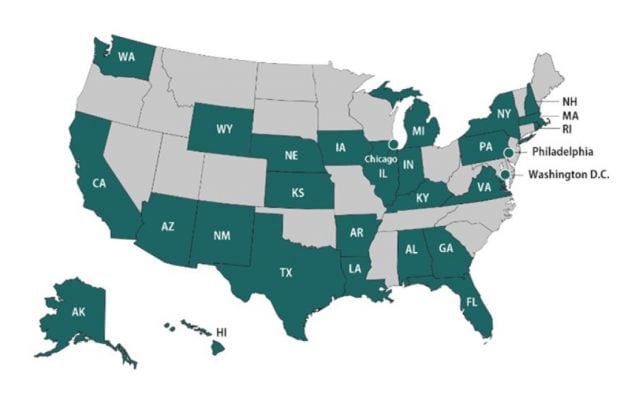OutbreakNet Enhanced 2020 Summary
Background
OutbreakNet Enhanced (OBNE) is a Centers for Disease Control and Prevention (CDC) program that is designed
to provide support to state and local health departments to improve their capacity to detect, investigate, control, and respond to enteric disease outbreaks. OBNE started in August 2015 with 11 sites. The program expanded and there are now 29 participating sites.
Program Highlights
In 2020, state and local health departments were significantly impacted by the COVID-19 pandemic. OBNE sites were affected as staff were immersed in COVID-19 response efforts and pulled from their regular duties, yet still faced the difficultly of balancing response work with enteric investigations. Due to competing priorities, many routine OBNE projects and activities were put on hold as OBNE sites learned to navigate the ‘new normal’ of enteric disease investigation during a global pandemic.
Many OBNE sites relied on student teams to conduct routine enteric interviews as regular staff were pulled into the COVID-19 response. Twenty-one OBNE sites have student teams that were critical in assisting both state and local health departments to conduct enteric interviews and helped improve the capacity to investigate enteric disease during the pandemic. Additionally, OBNE sites relied on existing strong partnerships with their regional Integrated Food Safety Centers of Excellence (CoEs), which assisted some sites with enteric diseases interviews, allowing OBNE staff to focus on the COVID-19 response.
Each year, OBNE sites showcase their annual work and provide updates at national meetings and conferences, including the Council of State and Territorial Epidemiologists (CSTE) Annual Meeting and the Integrated Foodborne Outbreak Response and Management (InFORM) conference and regional meetings; however, many events were cancelled in 2020. Despite this, OBNE sites shared their accomplishments with each other during monthly conference calls and were able to exchange strategies to help improve processes for enteric disease outbreak response during the pandemic. Program activities were also shared through success stories that were published to the OBNE website, such as Virginia’s investigation of Salmonella Braenderup outbreak associated with shell eggs in 2019.
Program Performance
OBNE performance metrics have been collected since 2016 to document the burden, timeliness, and completeness of enteric disease outbreak activities. Sites report metrics annually on both laboratory and epidemiologic aspects of outbreak investigations for Salmonella, Shiga toxin-producing Escherichia coli (STEC), and Listeria (collectively referred to as SSL metrics), as well as optional metrics for Shigella and Campylobacter. The metrics are analyzed and revised as needed to best meet program needs.
Page two includes figures and graphs of highlighted metrics for 2020. Information on all of the metrics, including complete data tables, is available on the OBNE website.
Select Metrics for Salmonella, STEC, and Listeria (SSL)

Over 35,000 cases reported

Over 750 clusters detected

Attempted interviews with an average of 84% of cases
Outbreak Investigation Related Metrics
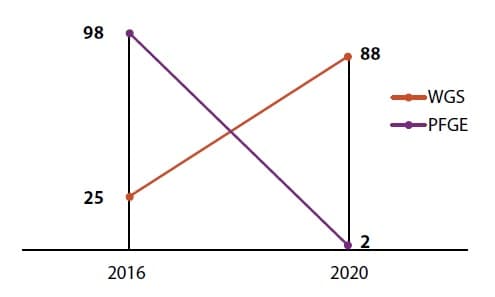
From 2016 to 2020, OBNE sites increased the total percentage of Salmonella, STEC, and Listeria (SSL) primary isolates with WGS testing while decreasing and transitioning from PFGE testing.
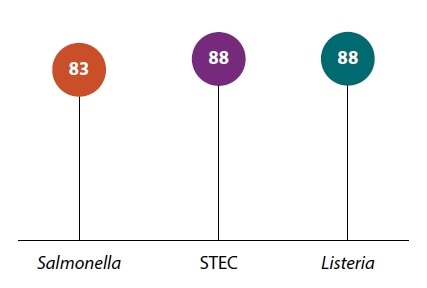
In 2020, OBNE sites attempted interviews with 83% of Salmonella cases and 88% of STEC and Listeria cases.
Improvements in Surveillance and Interviewing
OBNE sites increased the total percentage of SSL cluster and outbreak investigations in which analytic epidemiologic studies were conducted from 34% in 2016 to 47% in 2020.
OBNE sites increased the total number of SSL cluster and outbreak investigations where food and environmental samples were collected for testing from 20% in 2016 to 22% in 2020.
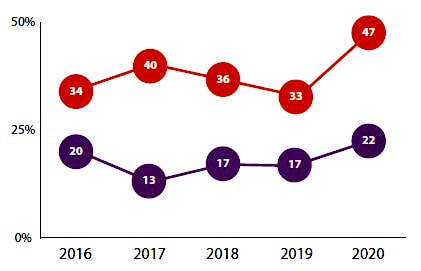
OBNE sites continue to improve the timeliness and completeness of enteric disease outbreak surveillance and response activities. They will continue to strengthen their outbreak response programs to conduct faster, better, and more complete investigations to help limit the spread of foodborne diseases.
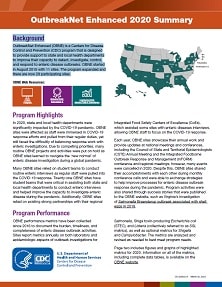
Download a print version of the OutbreakNet Enhanced 2020 Summary [PDF - 2 pages].
